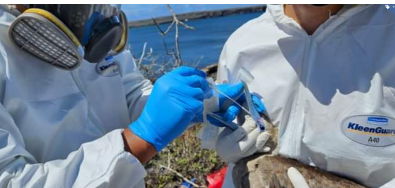#17,683
The Galapagos islands - an archipelago of more than 233 islands that lie roughly 600 miles off the west coast of Ecuador - due to its isolation and millions of years of evolution, is home to some of the most unique flora and fauna on the planet.
Made famous by English Naturalist Charles Darwin more than 160 years ago, in 1959 nearly all of this island group was granted protected status by the Ecuadorian public. There are a number of species on these islands that simply can't be found anywhere else on earth.
Three days ago the Galapagos National Park Directorate released a statement (below) indicating that `visibly sick birds on islands such as Wolf and Genovesa' had been reported, and that testing was underway. Avian H5N1 wasn't directly mentioned, but was obviously a concern given its expansion down the length of South America.
Overnight the Galapagos National Park Directorate confirmed that preliminary tests detected HPAI H5N1.
We get a bit more detail from a press release overnight from the UK's Galapagos Conservation Trust.
PRESS RELEASE
Three birds dead from avian flu in the Galapagos Islands© Galapagos National Park
Three birds found dead in the Galapagos Islands have tested positive for avian influenza (H5N1), according to preliminary results released by the Galapagos National Park Directorate (GNPD) on Tuesday 19 September.
The GNPD’s technical team and the Agency for the Control and Regulation of Biosecurity and Quarantine for Galapagos (ABG) are currently working to collect samples and carry out laboratory analysis to determine the cause of death of a number of birds found on several different islands. Of the five specimens examined so far, three have tested positive for H5N1, and the material collected will now be sent to the National Institute of Public Health Research (INSPI) in Guayaquil for confirmation.
Biosecurity protocols have been activated in Galapagos to reduce the risk of the virus spreading, including the closure of several tourist visitor sites on the islands of Genovesa, San Cristobal and Española. Tour operators have also been instructed to implement stricter procedures for disinfecting footwear and clothing before landing at other visitor sites, and to continuously disinfect outdoor public areas and dinghies used for disembarkation.
The GNPD and ABG continue to monitor the habitat and nesting areas of endemic bird species such as Galapagos penguins and flightless cormorants, and teams have been deployed across the Archipelago to assess the situation. Park guides and tour operators have also been asked to assist with monitoring the behaviour of wildlife, and to report any concerns immediately to the local authorities.
More than half a billion farmed birds have died or been culled globally due to avian flu since 2021, and it is estimated that hundreds of thousands of wild birds have died, including along the coast of mainland South America, where the virus has also killed thousands of sea lions.
“This deeply concerning news comes at a precarious time for marine life in Galapagos, with the developing El Niño event threatening the same populations of seabirds that are now highly vulnerable to the arrival of H5N1 in the Archipelago,” commented Dr Jen Jones, Chief Executive of Galapagos Conservation Trust.
“The way in which this virus has rapidly spread from farmed birds to wild animals across the globe, and the risks it poses to both wildlife and humans, is another reminder of how the health of people, animals and the environment are all connected. We continue to monitor this developing situation, and Galapagos Conservation Trust, along with our local partners, stands ready to support the Galapagos National Park in responding to this serious threat to the Islands.”
NOTES TO EDITORS:
• Galapagos Conservation Trust (GCT) is the only UK charity to focus exclusively on the conservation and sustainable development of the Galapagos Archipelago. To find out more, visit: galapagosconservation.org.uk
Even though H5N1 has yet to adapt well enough to mammals to spark a human pandemic, the damage it has done to (both avian and mammalian) wildlife across this planet is enormous. While almost certainly a massive under count, tens of thousands of marine and terrestrial mammals have been killed by the virus, and untold millions of birds.
The knock-on effects of these losses may not be fully appreciated for years, but it is unlikely you can rapidly remove large populations of wildlife without consequences.
Fewer birds may lead to more mosquitoes, an increase which could cause more vector-borne outbreaks in humans, like Dengue, Zika, or Malaria. H5N1 doesn't have to infect us to directly affect us.
Over the past couple of years the number of H5N1-free zones have evaporated around the globe, leaving only Australia and Antarctica unscathed, and the virus is knocking on Antarctica's door.
All of which must have Australia wondering how long the Wallace and Weber lines - imaginary dividing lines used to mark the difference between animal species found in Australia and Papua New Guinea and the rest of Southeast Asia - will hold back the virus.A risk assessment by SCAR Antarctic Wildlife Health Network (AWHN) predicts that Influenza virus H5N1 will hit the sub-Antarctic and Antarctic Peninsula this season with devastating impacts on seabird and pinniped colonies throughout the region.


